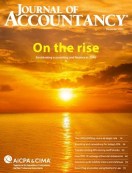- newsletter
- Cpa Insider

Make clients aware of their options for student loan debt relief
What clients don’t know about the student loan system can cost them.
Please note: This item is from our archives and was published in 2017. It is provided for historical reference. The content may be out of date and links may no longer function.
Related
Tax planning for Millennials
How CPAs can help clients with student loan debt
Number of workers raiding retirement funds rises
Student loans are a complicated matter that can leave many borrowers bewildered. If they face difficulty repaying their loans, often, they aren’t aware of all the options that are open to them. CPAs armed with the right information are well-positioned to help clients with student loans save a considerable amount of money, as the following case illustrates.
From forbearance to delinquency to default
One of our clients, whom I’ll call “Debbie” for the sake of this article, came to Consumer Debt Counselors Inc. with a student loan with a balance of $56,900 that was in default. A collection agency had sent her a letter of intent, and she was on the verge of having her wages garnished.
Debbie had original federal government student loan debt of just over $23,000. For 12 years she requested, and received, many forbearances on the debt. During a forbearance, she did not make repayments on her loan but interest continued to accrue and the loan was still considered current.
By 2016 the outstanding balance had grown to $56,900. When she was unable to secure another forbearance, she missed a payment and the loan became delinquent.
The delinquency period lasts for 270 days. After that, the loan servicer may declare the account in default, close the account, and send it to collections. Once a student loan is in default, there is a risk of both wage garnishments and tax refund offsets. A borrower in default must take steps to make the loan current.
Rehabilitation to ‘current’ status
Debbie knew very little about the options that were available to her. She hadn’t heard of any of the rehabilitation programs, and, though she vaguely knew about student loan forgiveness, she had no idea whether she would be eligible. This situation is hardly unusual; student loans and relief programs are complicated and hard for the layperson to navigate.
We reviewed Debbie’s finances and the history of her loan, and recommended she apply for a Rehabilitation Program (RP) with the collection agency: a program for borrowers who have defaulted on their federal student loan. In these programs, monthly payments are established. Once the borrower has made nine on-time payments in a ten-month period, the loan is sent back to the Department of Education loan servicer and is no longer considered in default. The loan is now considered current and is removed from the borrower’s credit history. In addition, it is no longer subject to wage garnishments and tax offsets.
Advisers should note that a borrower has only one opportunity to complete an RP. Once they have exhausted the program, they are no longer eligible if the loan defaults again.
Cancellation of federal student loans
At the start of the counseling session, we took Debbie’s work history. It quickly became apparent that with her background teaching in a low-income school district and working in public service that she would qualify for loan forgiveness.
Once Debbie had made enough payments to take her loan out of default, she qualified for the Teacher Loan Forgiveness Program. This program allows for a cancellation of up to $5,000 to individuals who are full-time teachers over five consecutive years in certain schools that serve low-income families. Some teachers are eligible for up to $17,500 if they are highly qualified secondary education teachers or work with children with disabilities.
Debbie had taught in an eligible low-income school for more than 10 years. She applied for and was granted forgiveness of $5,000 of her loan.
However, note that Debbie was eligible for the Teacher Loan Forgiveness program only because she did not consolidate her loans before applying. The program is available only to those who have demonstrated a commitment to teaching by teaching for several years. To qualify for the program, borrowers need to have been teaching for a certain number of years either without having ever consolidated their loans. If they consolidate their loans, any time spent teaching prior to consolidation will not count toward the Teacher Loan Forgiveness Program. Only time spent teaching after the loan consolidation will count.
Repayment
After the teacher loan forgiveness was approved, Debbie filed to consolidate her loans. Subsequently, she was approved for an Income Driven Repayment plan (IDR plan). Specifically, she qualified for the Revised Pay as You Earn Plan with initial monthly payments of $80. The actual amount will be adjusted annually depending on any future increases to her income.
After Debbie makes 120 monthly payments, she will be eligible for Public Service Loan Forgiveness, which will cancel the remainder of her loan. By 2027 (when she will have made 120 payments under her IDR plan, estimated to total $15,640) almost $63,000 of her student loans plus interest will be forgiven.
Conclusion
To accomplish this result, knowledge of the rules, careful planning, and guidance were needed. There are a few things that CPAs and people advising student loan borrowers can take away from this case:
- Don’t assume clients know about the opportunities they have to reduce their loan payments. Many student loan borrowers do not know about the forgiveness programs for which they may be eligible, nor do they understand the Income Driven Repayment plans that can make their student loan payments more manageable.
- Have a thorough understanding of student loans, forgiveness programs, and your client’s history.
- Pay particular attention to the order in which your client takes financial actions. Had Debbie consolidated her loans before learning about the Teacher Loan Forgiveness Program, she would not have been eligible. When it comes to helping a client find relief from high student debt, knowing the rules and timing is everything. Using a proprietary student loan software program, the counselor was able steer Debbie through the rules that would save her almost $63,000 in student loan repayments.
The case also demonstrates how CPAs have the skills necessary to assist federal government student loan borrowers solve the dilemma of monthly payments that are not affordable given their income level.
To learn more about assisting clients with student loan debt, read Sullivan and Towell’s previous articles on how CPAs can help clients with student loan debt, what to know before taking out a student loan, options for retirees who are paying a family member’s student loans, and debt relief for students who attended for-profit schools.
James Sullivan, CPA/PFS, is a board member and Melissa Towell is a student loan counselor at Consumer Debt Counselors, Inc., a not-for-profit debt counseling agency. To comment on this story, email senior editor Courtney Vien.



















